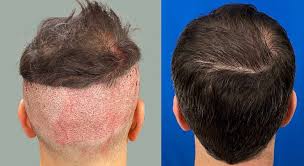
Follicular Unit Extraction (FUE)
Throughout the world, over 60% of men and 50% of women suffer from androgenetic alopecia (AGA) and irreversible hair loss. This type of hair loss is a seminatural process, and medication can only temporarily inhibit it. Many modalities have been tried over centuries to treat this type of baldness. Transplanting hair from an androgen independent site to the bald area is the latest surgical modality employed in this regard. In the past 10–15 years, a new hair restoration technique was introduced. This method is called follicular unit extraction (FUE) technique.
Principle of FUE
Androgenic alopecia is believed to be due to the sensitivity of hair to the androgenic hormone dihydrotestosterone (DHT). Hair on scalp also differs in their sensitivity levels to this hormone. Most of the hairs on the occipital region (back side) of scalp is resistant to this hormone whereas hair on frontal scalp and vertex are generally sensitive and are lost due to AGA.
Hair roots are distributed in groups in the scalp known as follicles. Each follicle may contain single, double, triple or multiple hairs. The technique of FUE aims at extracting such follicles from the donor area and transplanting them to the recipient area. The advantage of extracting follicles is that it gives more natural look at the recipient area where they are implanted as it closely simulates the physiological distribution of hair on the scalp.
Pre-Operative Considerations
The consultation starts with evaluation of the donor and the recipient areas. Our expert dermatologists will examine your scalp using high quality equipment and assess the degree of hair loss along with the density of hair at the donor area. One important factor to be determined at this point is the average number of multiple hair, and single hair follicles at the donor area which has a direct bearing on the end result. Other aspects like the thickness of individual hair strands, their curly nature etc will also be taken into consideration. Generally patients of grade 1 to 3 AGA are ideal candidates for FUE.
Other factors pertinent to the surgery like general health condition of the patient, other underlying diseases like diabetes, hypertension, and others will be assessed prior to the surgery.
Procedure
The procedure starts with administration of anaesthesia to the donor area. In most cases the donor area is the back of the scalp, but in cases where there is requirement of more number of grafts, beard area can also serve as a donor area. The grafts are then extracted using appropriate size punches and kept in physiological solution under low temperature. Once the extraction is completed the recipient area is anaesthetised similarly and the grafts are placed on the recipient area. This is done after taking special care to place the grafts at an optimum density and considering the direction of existing hair if any. The final results depends largely on the meticulousness of this step. The recipient area is dressed and the patient allowed to go home.
Post-Operative Care
Following the surgery, the patient need to keep the recipient area wet for about 2-3 days by spraying saline water so that the grafts don’t dry up. After that he/she can resume routine activities including resuming office work etc. It is better to avoid heavy physical exercise for a slightly longer period. As smoking hinders with healing it is generally advisable to refrain from smoking at least for a 2 to 3 weeks period following surgery.
Results
The transplanted hairs starts to grow at the recipient site once the graft is taken up. However a significant percentage of hairs may be temporarily shed due to shock of the procedure. This shock loss is reversable and fresh hair grows from the implanted roots. Even though the time taken for the hair to grow fully to natural lengths depends on many factors like growth rate, the indented length etc, it generally takes about 8 to 9 months to appreciate the final results.
